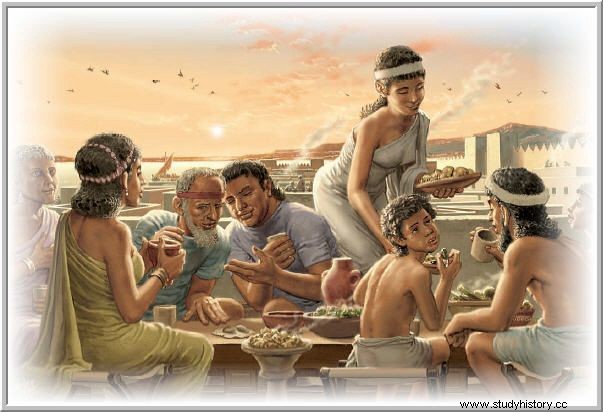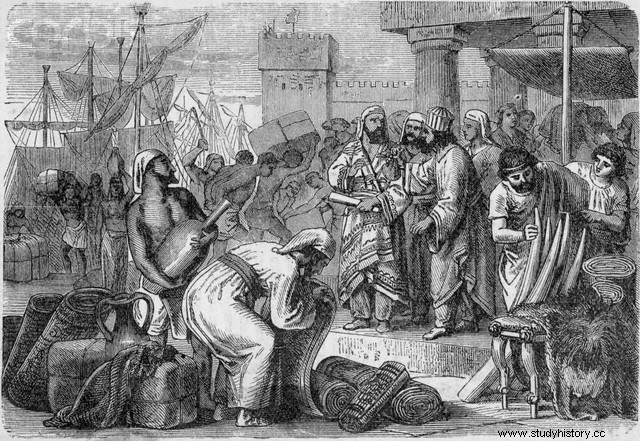One of the advantages of living in the middle of a trade route, and in a wonderfully fertile area, is that you enjoy a varied gastronomy. Thanks to this, the Sumerians even allowed themselves to write some of the first recipe books in history. Of course, let's not think that any neighbor's son could get between his chest and back the exquisite food. According to the tablets where the rations distributed to the workers were recorded, a lower-class Sumerian did not starve, but his diet was quite monotonous:porridge and herbal soups with the accompaniment of some tasty onion or turnip . The rich, as always, were another matter. And the world has changed little.

If a wealthy Sumerian were to visit a market with a few silver rings on his fingers or coils on his arm, he could choose from a wide variety of garden produce. The black heads not only discovered fallow and irrigation, but also the use of fruit trees and all kinds, to provide humidity and shade to the plants. He would also find animals and fish in abundance. The city of Ur It was erected 5 km from a huge swamp, where fishing and hunting were abundant. Eridu it was by the sea. Among the products that could be seen in a market were melons, onions, leeks, garlic, cereals (wheat and barley), legumes (lentils, chickpeas and beans), apples, figs, grapes, blackberries, pears, plums, licorice , rush roots, pomegranates, sedge, turnips, cumin, coriander, watercress, cucumber, lettuce, arugula, mustard, pumpkin, pine nuts (Pinus Alepensis ), almonds, pistachios, hazelnuts, various cheeses, hyssop, saffron, asafetida, fenugreek, olives... Among the fish, river fish stood out, and precisely in the city of Ur The largest fish dryer in Sumeria was built, along with the largest brewery... with 33 different varieties. The animal world was represented by sheep, goats, oxen, cows, rams, geese, herons, ducks and their eggs, lizards, turtles, crows, pigeons, chickens, gazelles and various deer and, above all, the pig. A proverb has been preserved that seems very modern to us:“They eat even the hooves of the pig ”.

Alongside the markets, it was common to find fried fish stalls, grasshopper skewers - a highly appreciated delicacy -, fruit in honey, syrup (pumpkin or fruit macerated in honey and boiled wine, usually palm, in this case) and bread, which it was sold thick and unleavened. The bread bought by the wealthy could have clarified butter, creamy sheep cheese spread or sesame and nuts. The Sumerians loved spicy sausages and patties, the latter being an obligatory food at weddings. The most expensive and chosen empanadas were pigeon empanadas with honey and river fish empanadas with Siqqu sauce. . This sauce, which only the very rich could afford, is thought to have been made with guts and remains of fish and shellfish, macerated and left to rot in the sun with aromatic plants. It must have looked a lot like the garum of the Romans. If a visitor came to your house, the polite thing to do was bring out a bowl of toasted barley bread, accompanied by salted butter, cottage cheese, honey or cream. We believe that the Sumerian cream must have been similar to our custard.
They were also fond of confectionery, highlighting the butter biscuits and those of fruit and fish with honey. The Sumerian ovens were made of clay, similar to those still used in India, and for this reason the queens of the confectionery of the two rivers were the cakes, which were made by sticking the dough to the wall of the oven. Cream, fig and pistachio cakes could not be missing at a party, and the most expensive of all of them was made in the city of Uruk, famous for its enormous palm groves. It was the dates and honey cake. As more than one will be thinking, it must have been quite cloying. And in case anyone has just remembered the possibility of getting cavities, we will note that the wealthy blackheads rubbed their teeth with licorice roots and with the twigs of a bush that has not yet been identified. Not only was it supposed to help prevent cavities, but it whitened teeth, and high-level priestesses were required to use those twigs daily, to give a good appearance of divinity. A goddess with yellow teeth does not please the faithful.
And to finish, and by popular request, I am enclosing three Sumerian recipes... let's see if you dare with them. Unfortunately, there are no indications of quantities on the tablets, so you will have to use your imagination or use the old trial-error system (or as my mother says, "by eye"). Have baking soda on hand and bon appetit.
TURNIPS AND LICORICE SOUP Directions:Liquorice roots are boiled for a long time in plenty of water. When it has been reduced by half, add asafetida, lemongrass, cypress pineapple and reduce it even more. Meanwhile, a broth is made with chicken bones, sheep's tail, garlic and milk. Finally, both broths are strained and combined. To that already filtered broth, onion, garlic, buckwheat, leek and turnips are added. When it is almost done add watercress and cumin. Before serving, sprinkle with mint. If desired, chicken meat can be added to the turnips.
RED BOILED LAMB :Lamb leg meat is taken and macerated in the animal's own blood for several hours. A broth is prepared with water, sheep tail fat, lamb offal and tripe, and boiled. It is then filtered and onions, leeks, buckwheat, shelled malt, cumin and coriander are added. When it starts to boil, add the meat and cook until tender. Before serving, it is sprinkled with barley cake crumbs and can be accompanied with baked bread with onion seeds and saffron.
DATE TRUFFLES :The dates are pitted and crushed. The paste is mixed with creamy cheese spread, honey and chopped pistachios. Small balls are formed that are coated in almond flour.
